It’s easy to provide the right ingredients to attract bumblebees to our gardens or landscapes. They visit flowers with a wide variety of colors and forms but do demonstrate a preference for certain nectar-rich plants. With their large size, long tongues and ability to fly farther than smaller native bees, bumblebees can access almost any flower they please. I encourage you to take a closer look, as bumblebees vary in size and coloration, and the patterns can help you identify what kinds of bumblebees are visiting your garden. These fuzzy bees need our help, and we can make a difference collectively by planting more native, bee-friendly forage in our gardens and landscapes.
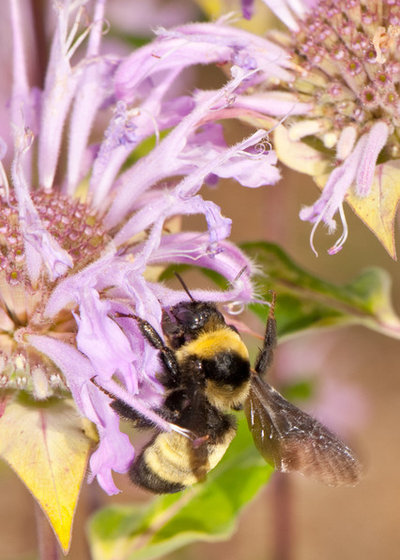
Holm Design & Consulting LLC
There are a number of bumblebee species in North America. The casual observer may not realize how many species occur where they live, as their coloration is similar in hue but the patterning or makeup of the colors varies. We have 18 species in my home state of Minnesota. Some of these species are now rare, as many bumblebee populations are in decline and have smaller ranges than historically documented.
Family: Apidae
Genus: BombusCommon name: Bumblebee
Numbers: 46 species in North America (north of Mexico), including 21 species east of the Mississippi River, and approximately 260 species worldwide
Distribution: Bumblebees occur in North and South America, Asia, Europe and northern Africa; they have been introduced into other countries, including New Zealand and Australia.
Habitat: Woodland edges, gardens, meadows, prairies and old fields
Shown: A black and gold bumblebee (
Bombus auricomis) on wild bergamot (
Monarda fistulosa)
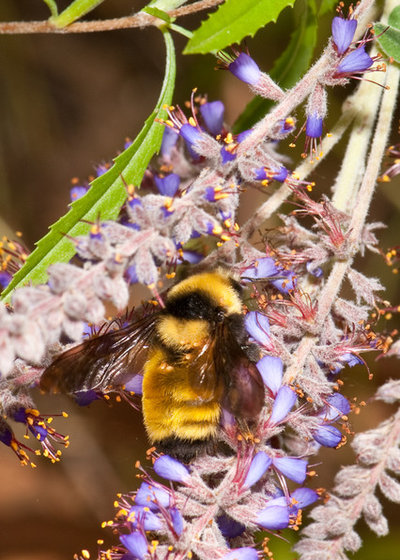
Holm Design & Consulting LLC
When to look for them: Bumblebees are active throughout the growing season, from spring through fall, with the time of year often determining what types of bumblebees you will likely observe. In early spring, queen bumblebees emerge from their overwintering site and begin foraging in the landscape. Queens will also be actively investigating potential nesting sites in holes in the ground or other cavities, such as crevices between rocks or protected spaces under structures. In the summer the smaller female worker bumblebees do most of the foraging and are out in greater numbers, compared with the foraging queens in spring. Late summer through fall is when many of the males are out foraging on flowers.
Shown: A yellow bumblebee (
Bombus fervidus) foraging on lead plant (
Amorpha canescens)
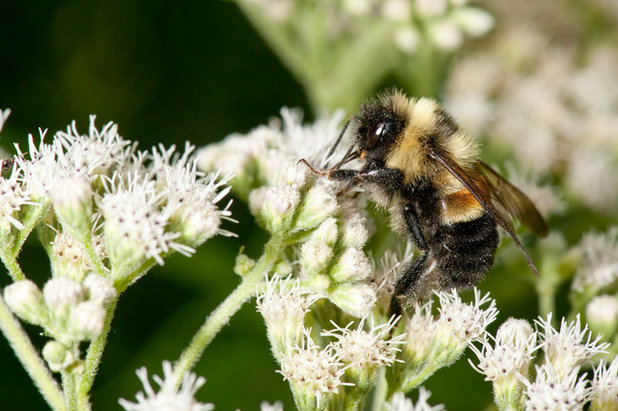
Holm Design & Consulting LLC
How They HelpBumblebees are generalist pollinators, meaning that they can, and will, visit a wide variety of flower forms and flower types. Using their large size and strength, they can manipulate complex flower forms that small bees are not capable of accessing. In addition to these traits, bumblebees have very long tongues that allow them to access hard-to-reach nectar in flowers. Bumblebees also have the ability to buzz-pollinate flowers, or in other words, shake the flowers by vibrating their flight muscles. This shaking releases pollen grains from pores in the flower’s anthers. Most flowers have anthers that shed pollen from the exterior, but a minority do not and require buzz pollination.
Bumblebees need a continuous succession of flowers in the garden and a variety of flower forms and colors. Early spring is an especially precarious time of year for bumblebees, because the formation of the colony is dependent upon the queen’s finding appropriate forage and a suitable nesting site.
Shown: A rusty patched bumblebee (
Bombus affinis), which
is an endangered bumblebee species
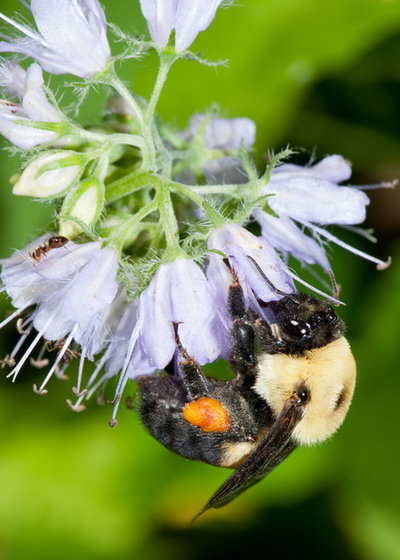
Holm Design & Consulting LLC
How to Spot BumblebeesAdults. Bumblebee queens for a given species are larger in size than their workers. Queens vary in size from species to species; the smallest are about ¾ inch (19 millimeters) long, and the largest are 1½ inches (38 millimeters) long.
Adults are black with white, yellow or orange hairs on the thorax and abdomen. The color combinations on workers (abdominal-hair-band colors and patterning on the thorax) can be used to help determine which species a bumblebee may be.
Like honeybees, bumblebee females collect pollen on their hind legs in pollen baskets (corbiculae). The pollen grains, when combed from the hairs on the thorax and abdomen to the hind leg, are mixed with a small amount of nectar and then compressed into a shiny mass before placement in the pollen basket. Males have large eyes and lack pollen baskets on their hind legs.
Babies (larvae). Larvae are grub-like and are pale yellow to cream in color. It is unlikely you will see larvae unless you uncover a nest.
Shown: A brown-belted bumblebee (
Bombus griseocollis) foraging on Virginia waterleaf (
Hydrophyllum virginianum)
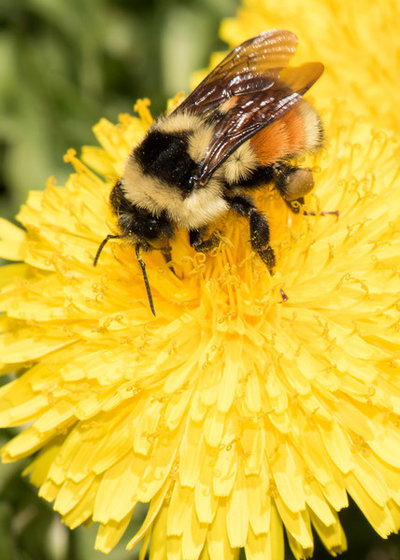
Holm Design & Consulting LLC
How to Lure ThemDo not disturb. Besides providing a pesticide-free garden and continuous succession of flowering plants, it is important to not disturb an existing bumblebee nest in your landscape. Bumblebee queens look for an insulated place to initiate a nest. This can include locations such as a rodent hole in the ground and under a pile of leaves or grass clippings in the yard. Bumblebee nests are annual, and the bees need an entire season for the colony to fully develop, and to produce offspring and females that will become queens the following season.
It is not uncommon to observe a queen bumblebee in early spring investigating various places in your landscape for a place to nest. She typically will fly low to the ground and go in and out of rodent holes and crevices between rocks, and under structures or similar places. If you are patient, you may see where she ultimately chooses to nest in your landscape, and you will know where to minimize disturbance. Later in the summer is also when nests are discovered, when people see bumblebee workers flying to and from a particular spot in the landscape.
Maintain a bee-safe yard. Do not use pesticides, especially insecticides, in the garden, particularly on flowering plants.
Shown: A tricolored bumblebee (
Bombus ternarius)
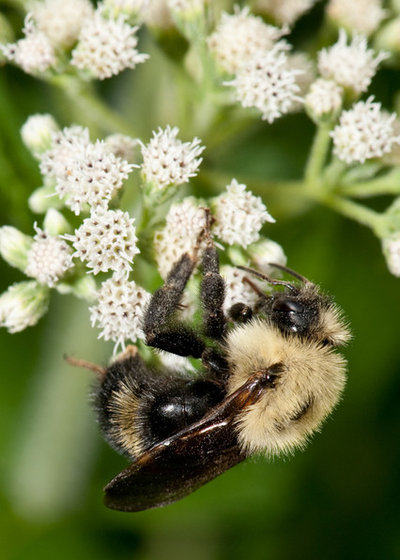
Holm Design & Consulting LLC
Provide forage plants for adults. Bumblebees are generalists (visiting a wide variety of plants). It is important to provide forage throughout the growing season, but is most important in spring for the queens.
Sample plant list for adults:- Spring (forage for queens): Wild geranium (Geranium maculatum), cream indigo (Baptisia bracteata), Virginia waterleaf (Hydrophyllum virginianum), wild plum (Prunus americana), American bladdernut (Staphylea trifolia), dogwoods (Cornus spp), Dutchman’s breeches (Dicentra cucullaria), spiderwort (Tradescantia spp) and wild lupine (Lupinus perennis)
- Summer (forage for workers): Lead plant (Amorpha canescens), prairie clover (Dalea spp), wild bergamot (Monarda fistulosa), beardtongues (Penstemon spp), vervains (Verbena spp), milkweeds (Asclepias spp), white turtlehead (Chelone glabra), spotted Joe Pye Weed (Eupatorium maculatum), purple coneflower (Echinacea purpurea), Amercian basswood (Tilia americana), blazingstar (Liatris spp) and blue lobelia (Lobelia siphilitica)
- Late summer and fall: Goldenrod (Solidago spp), gentians (Gentiana spp), sneezeweed (Helenium autumnale) and asters (any species)
Browse native plants for your region
Shown: A lemon cuckoo bumblebee (
Bombus citrinus)
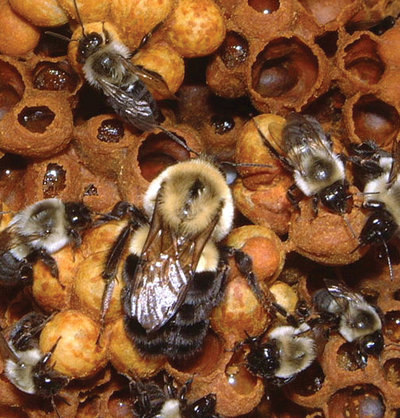
Befriending Bumble Bees
Life cycle. Bumblebee nests are social places, with two generations (a queen and her offspring) and a division of labor; the bees have various roles or jobs in the colony. The colony begins as a solitary nest in the spring, with just the queen finding and initiating the nest. The queen establishes a nesting site in an insulated place, such as in an abandoned rodent hole belowground, under a leaf pile or in another warm, dry location. She then forages for pollen and nectar from flowers in the landscape near the nesting site.
In the nest the queen forms a large pollen ball where she lays several eggs. The hatched larvae are initially female (workers). These larvae feed on the pollen as they develop. Because nests are established in early spring when temperatures can plummet, the queen will rest on the pollen ball, incubating the eggs to keep them warm. In the nest the queen also constructs wax cups, or nectar pots. When she and, later, the workers return to the nest, she regurgitates the nectar collected from flowers into the nectar pots. This provides a food store so that during inclement weather, bumblebees have enough food to remain inside the colony until the weather improves to resume foraging. When her initial female broods pupate and become adults, they largely take over foraging in the landscape for pollen and nectar, while the queen remains in the nest continuing to lay eggs and produce more offspring. Workers also help the queen in the nest with rearing the brood and other nest duties.
Shown: A bumblebee nest with the large queen in the center surrounded by her daughters (workers)
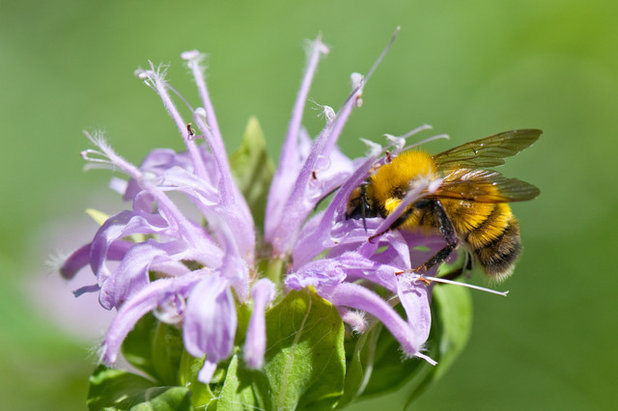
Holm Design & Consulting LLC
Bumblebee colonies continue to grow in size over the summer, reaching their peak in fall. The colony produces males in late summer. These males mate with females from the colony that are destined to become queens the following season.
The entire bumblebee colony dies in the fall, except for the newly mated females. These females find an insulated place to spend the winter, typically below ground in an old rodent hole, then emerge the following spring as the soil begins to warm. The annual bumblebee life cycle begins in the spring with the queens establishing a nesting site and ultimately a colony of workers.
Shown: A perplexing bumblebee (
Bombus perplexus) visits wild bergamot (
Monarda fistulosa), one of the preferred forage plants in midsummer
Region by region: What to do in your garden this month





